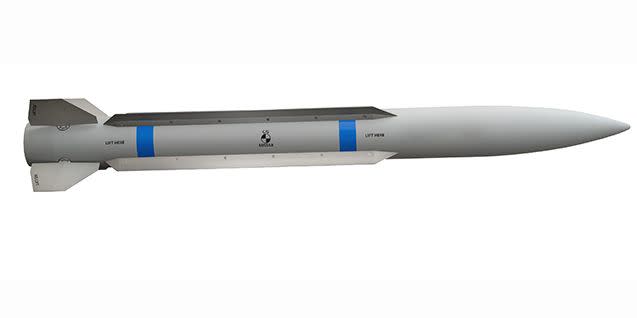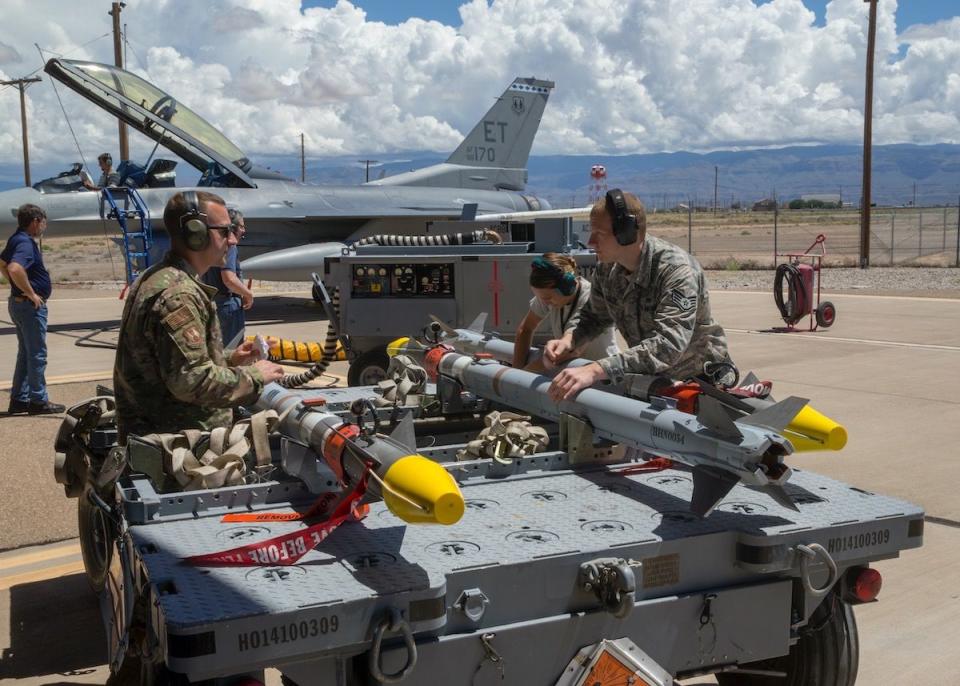The F-35 Is About to Enter Beast Mode

Raytheon's new Peregrine missile is designed for U.S. fighter jets and would likely replace the 30-year old AMRAAM missile.
Peregrine is smaller than existing missiles, allowing the Air Force and other services to stuff more of them in the internal weapons bays of stealth fighter jets like the F-35.
The missile is also cheaper to buy and maintain than existing missiles, making it easier to maintain large inventories.
U.S. defense contractor Raytheon has pulled the curtain off a new missile designed to boost the firepower of fighter jets. The new Peregrine missile (above) is designed to fit in the weapons bays of stealth fighters, allowing them to carry more missiles than ever before.
As stealthy fighter jets, the F-22 Raptor and F-35 Lightning II both suffer from a major problem: They must store all of their fuel, sensors, and weapons internally. While previous-generation fighters stored this equipment on the fuselage and wingtips, having a collection of pointy missiles, bombs, and fuel tanks hanging off an aircraft can dramatically increase its radar signature. Fifth-generation fighters like the F-22 and F-35 store everything internally, particularly weapons, maximizing the ability of their carefully molded shapes to evade radar.

But that comes at a cost. There’s only so much room inside a jet, and the amount of weapons a plane can carry is limited by the size of its weapons bays. The F-35, for example, has two bays that can carry up to four AMRAAM air-to-air missiles. That’s only half as many missiles as fourth-generation fighters can comfortably carry. Although capable, the AMRAAM is basically a 30-year-old missile designed for the old days when missiles were carried outside the aircraft.
The new Peregrine missile was revealed earlier this week by Raytheon at the Air Force Association’s National Conference. Peregrine, named after a North American falcon that preys on other birds, is just 6 feet long and weighs 150 pounds. The AMRAAM, by contrast, is 12 feet long and weighs approximately 335 pounds. Peregrine looks very similar to the SM-1/2/3/6 Standard series of naval surface-to-air missiles also manufactured by Raytheon.
Raytheon unveils Peregrine medium-range air-to-air missile at #ASC19. pic.twitter.com/gjPNla3USf
— Steve Trimble (@TheDEWLine) September 16, 2019
As reported by Aviation Week & Space Technology, Raytheon states that the missile uses a “multimode autonomous seeker,” which could include both infrared and radar sensors to guide the missile to target. The missile is equipped with a blast fragmentation warhead to down enemy aircraft.
Propulsion is described as described as a “new, high performance propulsion section” that gives a missile half the size of AMRAAM a slightly better range. The missile is described as having very good maneuverability in the “endgame” stage, giving it the ability to chase down aircraft trying to evade it in the moments before intercept.
Meanwhile, Air Force Magazine reports Peregrine “will cost ‘significantly less’ to buy and maintain than the AIM-120 or AIM-9X, and is faster to develop, thanks to ready-made components and additive manufacturing.” That’s important because the cost of missiles, like fighter jets, is skyrocketing: AIM-120C7, the latest version of the AMRAAM was recently sold to Japan and Hungary for between $2 and $2.7 million each including missiles, software, supporting equipment, and contractor field support. If Air Force fighters can suddenly carry many more missiles, the service needs to be able to afford them.

How many Peregrines can an aircraft like the F-35 carry? It’s not clear, but it’s possible that if Peregrine is half as long as AMRRAM, an F-35 could carry twice as many of them. That would mean each F-35 could carry eight missiles—and even more missiles on external hardpoints if mission planners were willing to trade stealth away.
It’s even possible that the Air Force could team an F-35 carrying Peregrines internally with an F-35 carrying the missiles both internally and externally, with the former jet quietly spotting targets for the latter. Lockheed Martin has teased a notional “beast mode” for the F-35 that has it carrying 16 AMRAAM and Sidewinder air-to-air missiles, 12 externally. With Peregrine, it might carry up to 20 missiles.
As the F-35 program rolls on, it's likely the short-range Sidewinder and medium-range AMRAAM missiles will be replaced by the medium-range Peregrine or the similarly sized Cuda missiles under development by Lockheed Martin. The long-range Joint Advanced Tactical Missile, or AIM-260, might replace two medium-range missiles internally, but engage at even greater distances.
The trend is clearly toward longer-range missiles that take advantage of a web of battlefield sensors and data sharing to shoot down adversaries first. That could enable American and allied air forces to fight—and win—even outnumbered.
You Might Also Like

